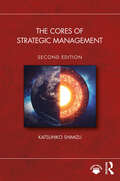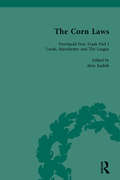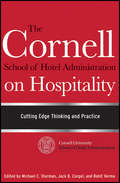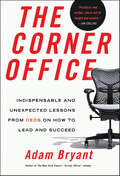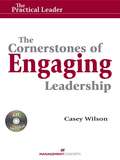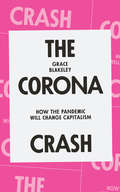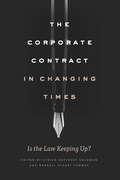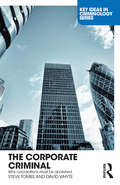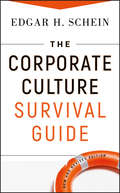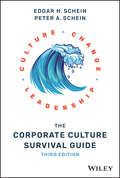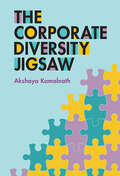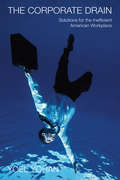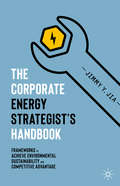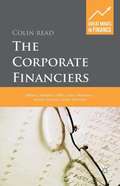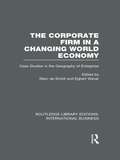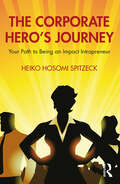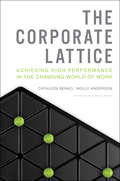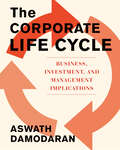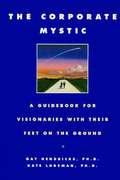- Table View
- List View
The Cores of Strategic Management
by Katsuhiko ShimizuThe Cores of Strategic Management provides students with a concise introduction to the fundamentals of strategic management, including business-level and corporate-level strategy, leadership, decision-making, and strategy implementation.Designed to guide students to master the core concepts and learn how to apply these basics through case studies, students will be better equipped to approach and resolve even the most complex problems within the field. This second edition has been fully revised throughout to incorporate an international perspective, including examples and case studies from across borders that reflect the current state of the field.This text is core reading for undergraduate, postgraduate, and executive students of Strategic Management and will equip any student with the strategic management fundamentals and strategic thinking skills needed to succeed in continuously changing environments. This book will also be accompanied by online resources for the use of instructors, including PowerPoint slides.
The Corn Laws Vol 5: The Formation Of Popular Economics In Britain
by Alon KadishThe pamphlets, newspaper articles and tracts in this collection provide source material for the study of the Anti-Corn Law campaigns of the 1830s and 1840s and their role in the formation of popular economics in Britain. Volume 5 covers entries from 1839 to 1842.
The Cornell School of Hotel Administration on Hospitality: Cutting Edge Thinking and Practice
by Michael C. Sturman Jack B. Corgel Rohit VermaThis cutting edge and comprehensive book-with contributionsfrom the star faculty of Cornell University's School of HotelAdministration-offers the latest thinking on the bestpractices and strategies for hospitality management. A must forstudents and professionals seeking to enter or expand their reachin the hospitality industry, The Cornell School of HotelAdministration on Hospitality delivers the authoritative advice youneed to:Develop and manage a multinational career and become a leader inthe hospitality industryMaximize profits from franchise agreements, managementcontracts, and leasesUnderstand and predict customer choices, and motivate your staffto provide outstanding serviceManage hospitality businesses and the real estate underlying thebusinessesControl costs, coordinate branding strategy, and manageoperations across multiple locations
The Corner Office: Indispensable and Unexpected Lessons from CEOs on How to Lead and Succeed
by Adam BryantDozens of top CEOs reveal their candid insights on the keys to effective leadership and the qualities that set high performers apartWhat does it take to reach the top in business and to inspire others? Adam Bryant of The New York Times decided to answer this and other questions by sitting down with more than seventy CEOs and asking them how they do their jobs and the most important lessons they learned as they rose through the ranks. Over the course of extraordinary interviews, they shared memorable stories and eye-opening insights.The Corner Office draws together lessons from chief executives such as Steve Ballmer (Microsoft), Carol Bartz (Yahoo), Jeffrey Katzenberg (DreamWorks), and Alan Mulally (Ford), from which Bryant has crafted an original work that reveals the keys to success in the business world, including the five essential personality traits that all high performers exhibit—qualities that the CEOs themselves value most and that separate the rising stars from their colleagues. Bryant also demystifies the art of leadership and shows how executives at the top of their game get the most out of others.Leadership is not a one-size-fits-all skill, and these CEOs offer different perspectives that will help anyone who seeks to be a more effective leader and employee. For aspiring executives—of all ages—The Corner Office offers a path to future success.
The Cornerstones of Engaging Leadership (with CD)
by Casey WilsonIn the 21st Century, people are the competitive advantage. The talent and level of dedication of an organization's workforce make the difference in achieving success. The traditional command-oriented leadership style is not enough to keep today's employees motivated—they need to be engaged. They need passion, connection, and inspiration, and a willingness to put forth their best efforts to benefit themselves and their organization. The Cornerstones of Engaging Leadership connects what we know about engagement on an organizational level to what an individual leader can do to increase engagement. Using real-world examples, Wilson reveals the key actions leaders must take to connect with and engage others: •Build trust•Leverage unique motivators•Manage performance from a people-centric perspective•Engage emotions By committing to these four cornerstones of engaging leadership, leaders can unleash the potential of others and inspire effective performance. Through practice tools and exercises (all available for download on a supplemental CD-ROM), readers are challenged to explore, reflect upon, and apply key concepts and techniques of the engaging leader approach.
The Corona Crash: How the Pandemic Will Change Capitalism (CORONAVIRUS PAMPHLETS)
by Grace BlakeleyFree market, competitive capitalism is dead. The separation between politics and economics can no longer be sustained.In The Corona Crash, leading economics commentator Grace Blakeley theorises about the epoch-making changes that the coronavirus brings in its wake. We are living through a unique moment in history. The pandemic has caused the deepest global recession since the Second World War. Meanwhile the human cost is reflected in a still-rising death toll, as many states find themselves unable—and some unwilling—to grapple with the effects of the virus. Whatever happens, we can never go back to business as usual. This crisis will tip us into a new era of monopoly capitalism, argues Blakeley, as the corporate economy collapses into the arms of the state, and the tech giants grow to unprecedented proportions. We need a radical response. The recovery could see the transformation of our political, economic, and social systems based on the principles of the Green New Deal. If not, the alternatives, as Blakeley warns, may be even worse than we feared.
The Coronavirus (COVID-19) Pandemic and the Global Economy (A)
by Alberto F. Cavallo Christian GodwinIn early 2020, a coronavirus pandemic swept the globe, ushering in unprecedented disruptions to the global economy. Both supply and demand were decimated by lockdowns and border closings, as well as reduced spending by fearful consumers. In response, governments around the world made equally unprecedented policy moves, spending trillions of dollars on fiscal stimulus measures to bridge the gap during the self-imposed shutdown. As the pandemic progressed, governments had to weigh the costs between loss of life due to opening up their economies and the economic devastation caused by delaying a reopening.
The Coronavirus (COVID-19) Pandemic and the Global Economy (B)
by Alberto F. Cavallo Christian GodwinBy December 2020, the COVID-19 pandemic had swept across the globe, creating widespread disruption in all aspects of everyday life. Almost 90 million people had been infected and nearly two million had died from the disease. By this point in the pandemic-a year since the first rumors about the novel virus began, mask-wearing and social-distancing had become routine, and millions of people were working or studying from home. Grief and anxiety were widespread due to the loss of loved ones, financial hardships, and uncertainty about when the pandemic would recede. Meanwhile, the global economy was experiencing the worst crisis in decades, with a recovery that was slow, uncertain, and uneven. By the end of the year, it was clear that the economic crisis would not end until the virus was under control. To accomplish this, governments worldwide were relying on private companies to fast-track the development and distribution of COVID-19 vaccines, hoping for a return to normalcy in 2021.
The Coronavirus Pandemic and Inequality: A Global Perspective (Global Perspectives on Wealth and Distribution)
by Shirley Johnson-LansThis book examines the effects of the Covid-19 pandemic on the degree of inequality in wellbeing (income and wealth, health, access to health care, employment, and education) in a number of different countries around the globe. The effect of socioeconomic inequality within a country on the outcome of the pandemic is also considered. This book studies the differential effects of Covid based on location, age, income, education, gender, race/ethnicity, and immigrant status. Special attention is devoted to indigenous populations and those who are institutionalized. The short- and long-term effects of public policy developed to deal with the pandemic’s fallout are studied, as are the effects of the pandemic on innovations in health care systems and likely extensions of public policy instituted during the pandemic to alleviate unemployment, poverty, and income inequality.
The Corporate Contract in Changing Times: Is the Law Keeping Up?
by Steven Davidoff Solomon Randall Stuart ThomasOver the past few decades, significant changes have occurred across capital markets. Shareholder activists have become more prominent, institutional investors have begun to wield more power, and intermediaries like investment advisory firms have greatly increased their influence. These changes to the economic environment in which corporations operate have outpaced changes in basic corporate law and left corporations uncertain of how to respond to the new dynamics and adhere to their fiduciary duties to stockholders. With The Corporate Contract in Changing Times, Steven Davidoff Solomon and Randall Stuart Thomas bring together leading corporate law scholars, judges, and lawyers from top corporate law firms to explore what needs to change and what has prevented reform thus far. Among the topics addressed are how the law could be adapted to the reality that activist hedge funds pose a more serious threat to corporations than the hostile takeovers and how statutory laws, such as the rules governing appraisal rights, could be reviewed in the wake of appraisal arbitrage. Together, the contributors surface promising paths forward for future corporate law and public policy.
The Corporate Criminal: Why Corporations Must Be Abolished (Key Ideas in Criminology)
by David Whyte Steve TombsDrawing upon a wide range of sources of empirical evidence, historical analysis and theoretical argument, this book shows beyond any doubt that the private, profit-making, corporation is a habitual and routine offender.? The book dissects the myth that the corporation can be a rational, responsible, 'citizen'.? It shows how in its present form, the corporation is permitted, licensed and encouraged to systematically kill, maim and steal for profit.?? Corporations are constructed through law and politics in ways that impel them to cause harm to people and the environment.? In other words, criminality is part of the DNA of the modern corporation.? Therefore, the authors argue, the corporation cannot be easily reformed.? The only feasible solution to this 'crime' problem is to abolish the legal and political privileges that enable the corporation to act with impunity.
The Corporate Culture Survival Guide
by Edgar H. ScheinThe father of the corporate culture field and pioneer in organizational psychology on today's changing corporate cultureThis is the definitive guide to corporate culture for practitioners. Recognized expert Edgar H. Schein explains what culture is and why it's important, how to evaluate your organization's culture, and how to improve it, using straightforward, practical tools based on decades of research and real-world case studies. This new edition reflects the massive changes in the business world over the past ten years, exploring the influence of globalization, new technology, and mergers on culture and organization change. New case examples help illustrate the principals at work and bring focus to emerging issues in international, nonprofit, and government organizations as well as business. Organized around the questions that change agents most often ask, this new edition of the classic book will help anyone from line managers to CEOs assess their culture and make it more effective.Offers a new edition of a classic work with a focus on practitionersIncludes new case examples and information on globalization, the effects of technology, and managerial competenciesCovers the basics on changing culture and includes a wealth of practical advice
The Corporate Culture Survival Guide (J-b Warren Bennis Ser. #158)
by Edgar H. Schein Peter A. ScheinEffective, sustainable cultural change requires evolution, not disruption The Corporate Culture Survival Guide is the essential primer and practical guide every organization needs. Corporate culture pioneer Edgar H. Schein breaks the concept of 'culture' down into real terms, delving into the behaviors, values, and shared assumptions that define it, and explains why culture is the central factor in an organization's success—or failure. This new third edition is designed specifically for practitioners needing to apply these practices in real-world settings, and has been updated with new coverage of globalization, technology, and managerial competencies. You'll learn how to get past subconscious bias to assess whether or not your existing culture truly serves your organization, and how to introduce change and manage the change process over time for a best-case-scenario outcome. Case studies illustrate successful change in real companies, providing models and setting the bar for dismantling dysfunctional cultures. Corporate culture begins with the founder, and evolves—or not—over time. Is your culture working for or against your organization? How can it be optimized? This book separates the truth from the nonsense to provide real-world guidance on initiating and managing cultural change. Understand when to assess your culture, and how to do it objectively Learn how cultures evolve and change over time, for better or worse Discover the reality of multiculturalism amidst the rise of globalization Evolve your culture to more effectively serve your organization Each of us is a part of many cultures—what you do, where you live, where you grew up, what you enjoy, how you live; in the workplace, many different people with many different cultures come together toward a common goal—will these cultures clash or synergize? The Corporate Culture Survival Guide shows you how to create an overarching corporate culture that gets everyone on the same page to drive your organization's success.
The Corporate Diplomacy Challenge: A Leader's Guide to Navigating this Important Career Transition
by Michael D. WatkinsMany leaders are used to wielding authority and making executive decisions with their place in the hierarchy in mind. But what happens when leaders move into positions where getting things done suddenly depends more on influence and the ability to build coalitions of support than on authority? Whether your new role involves navigating within a "matrix" organization, negotiating with powerful external partners, such as government agencies, or leading a critical support function, such as HR or IT, without control over critical budgets, you need to learn how to practice corporate diplomacy--effectively leveraging organizational alliances, networks, and other business relationships to get things done. In this chapter, transition acceleration expert Michael Watkins shows you how. This chapter was originally published as Chapter 3 of "Your Next Move: The Leader's Guide to Navigating Major Career Transitions."
The Corporate Diversity Jigsaw
by Akshaya KamalnathAlthough diversity in companies is a topic of great interest, significant aspects of the issue are often left out of the debate. The Corporate Diversity Jigsaw connects all the dots so that steps taken to address issues of diversity in business organisations can be more effective. Akshaya Kamalnath offers a nuanced justification of exactly what types of diversity are most useful for corporations, where they should be implemented, and how best to address diversity in ways that account for recent social movements such as #MeToo and Black Lives Matter. After a critical assessment of quotas and disclosure requirements across jurisdictions, she provides a different way to solve the problem, by encouraging companies to make improvements to their culture and internal processes. This timely book offers a balanced analysis, practical solutions, and fresh perspectives on how corporate culture and social movements impact diversity efforts.
The Corporate Drain: Solutions for the Inefficient American Workplace (The\corporate Drain Ser.)
by Yoel Yohan“His candid insight . . . transforms the boardroom business as usual attitude and leads your corporation to a higher platform of performance.” —Dr. Norman (Chip) Harbaugh, MD, FAAP, CEO/Chairman of the Board-Emeritus/Founder, Kids Health FirstIt’s time to look at a typical day at work in corporate America and how bad habits, bad procedures, and bad communication creep into the workplace, undermining productivity. Business experts agree that procedural inefficiency is an all-too-familiar theme in today’s workplace and that eliminating it is one of business managers’ most important responsibilities.The Corporate Drain provides business leaders with tools to recognize problems and tips for raising efficiency and improving performance, such as:Unclogging the flood of information (emails, paper reports, meetings, and conference calls)Maximizing the potential of each employee using cost-effective incentivesHow training can never be underestimated or over-appliedThe globalization of the business world challenges American companies to observe and understand how cultural diversity affects their operations. Author Yoel Yohan, raised in India and educated at a British military school, accredits his successful career at global giant, United Parcel Service, in part to his own cultural diversity.In The Corporate Drain, Yohan provides powerful examples and tools for profitable growth in today’s international marketplace.“Addresses the shortfalls in corporate America and uses a common-sense approach in fixing workplace problems. Yoel integrates appropriate humor and not only educates but entertains as well.” —Bill Ribble, former UPS VP“Yoel has captured the essence of American corporate culture. His recommended solutions can be easily implemented in any business.” —Atif Abdulmalik, CEO, Arcapita Bank
The Corporate Energy Strategist’s Handbook: Frameworks to Achieve Environmental Sustainability and Competitive Advantage
by Jimmy Y. JiaIn an era in which scientists say we are approaching a point of no return in terms of climate change, companies are looking for ways to improve productivity of innovations that reduce environmental footprints. Among the questions they are looking to answer are: How can financial tools be leveraged for positive energy outcomes? How can the energy strategy be integrated into board responsibility? This book provides answers to these questions and more, presenting a selection of decision-making frameworks for strategy and sustainability management. Comprehensive in scope, its 120 frameworks—some well-known while others are original—provide a thorough, practical guide to inform the sustainability strategy of your organization. In addition to learning how to green your organizational strategy, you will also learn how to communicate your strategy to your teams. An essential source for executives desiring to be more responsible in energy performance and to decarbonize their operations, this book will prove useful in your day-to-day organizational work.
The Corporate Financiers
by Colin ReadThe Corporate Financiers is the fifth book in aseries of discussions about the great minds in the history and theory offinance. While the series addresses the contributions of scholars in ourunderstanding of modern finance, this volume presents the ways in which acorporation creates value. Morethan two centuries ago, Adam Smith explained the concept of division of laborand the efficiencies of specialization as the mechanism in which a firm createsvalue. However, corporations now find themselves outsourcing some processes toother firms as an alternative way to create value. There must be other economicforces at work than simply the internal efficiencies of a firm. We begin bydescribing the work of a rather obscure scholar named John Burr Williams who demonstratedin 1938 how the earnings of a firm are capitalized into corporate value throughits stock price. We then delve into the inner workings of the moderncorporation by describing the contributions of Nobel Memorial Prize winnersRonald Coase and Oliver Williamson. More than any others, these scholarscreated a renewed appreciation for our understanding of the institutionaldetail of the modern corporation in reducing costs and increasing efficiency. WhileCoase and Williamson provided meaningful descriptions of the advantage of acorporation, they did not offer prescriptions for the avenues the corporationcan create more value in an era when new technologies make outsourcing andtelecommuting increasingly possible. Michael Jensen and William Mecklingdescribe in greater detail the nature of the implicit contracts a corporationemploys, and recommend remedies to various problems that arise when the goalsof the corporation are not aligned with the incentives of its agents. We alsodescribe the further nuances to these relationships as offered by Armen Alchianand Harold Demsetz. We treat the lives of these extraordinary individuals wholooked at a very familiar problem in a sufficiently novel light to change theway all look at corporations ever since. That is the test of genius.
The Corporate Firm in a Changing World Economy: Case Studies in the Geography of Enterprise (Routledge Library Editions: International Business)
by Egbert Wever Marc De SmidtThis book examines the economic environment and phenomena of multinational business with reference to case studies of major multinational companies, including IBM, Philips, Nissan and Volvo. It assesses how the major theories explaining the response of companies to changes are borne out by the experience of individual firms.
The Corporate Hero's Journey: Your Path to Being an Impact Intrapreneur
by Heiko Hosomi SpitzeckImpact intrapreneurs at some of the most powerful organizations in the world are designing new, more sustainable businesses from within. They put their values to work and transform their corporations into a force for good. In a corporate world that still largely prioritizes profit above all else, these people shine a light on how to balance profit with impact, and the inspirational stories captured in this book guide leaders and managers to do the same.The lack of purpose beyond profit is causing millions of people to question their work and even to leave the corporate world altogether. Companies are struggling with recruitment and retention, as people seek a greater sense of purpose. For many, this would mean finding a way to use their work as a platform for positive social and environmental impact. This book will inspire this change for leaders seeking a different and better way forward. Structured around the stages of Joseph Campbell’s hero’s journey – upon which Star Wars was based – this book combines the philosophy of Star Wars with inspiring stories of impact intrapreneurs. You’ll get to know Corporate Jedi such as Susie Lonie and Nick Hughes, who, while working for Vodafone in Kenya introduced a mobile payment method which brought financial inclusion to millions; Myriam Sidibé at Unilever, who turns making soap into saving lives; and Gib Bulloch, founder of Accenture Development Partnerships, which provides first-class consulting services to NGOs leveraging their impact. With actionable advice, such as how to create a business case, how to measure social impact, and more, the book is not only an entertaining read, but also helps executives apply insights to their own daily work.Written for leaders, managers, and all professionals looking to create positive impact through their work, this book will give future Corporate Jedi the courage and tools to use the force of business for good.
The Corporate Immune System: Maintaining the Health of the Community
by Arie De GeusMuch like the human body, your organization is open to intruders - some good, some bad. This chapter shows how you can repel some intruders and maintain and manage others.
The Corporate Lattice
by Molly Anderson Cathleen BenkoWith roots planted firmly in the industrial age, the corporate ladder has been the metaphor used to describe the prevailing one-size-fits-all model for success. At its heart, the ladder is derived from inflexible, hierarchical, organization models in which prestige, individual rewards, information flow, power and influence are tied to the rung each employee occupies. Yet the workplace as we know it is in transition -- evolving away from the linear, one-size-fits-all model of the corporate ladder toward a multidimensional approach that Cathy Benko calls the corporate lattice.This book will serve to widen an organization's strategic lens, representing a fundamentally new way to work and run a company. It offers a framework to help senior leaders and HR directors harness the talent in their company in a way that provides a strategic advantage, not only for recruiting but also for achieving and maintain better individual performance.In the bestselling book Mass Career Customization (Harvard Business Press/2007), Cathy Benko and Deloitte provided the breakthrough MCC dashboard for understanding the important variables of individual employees' career-life profiles, but she also coined a new metaphor -- the corporate lattice -- as a way to think about the changed career landscape. This book delves much deeper into the power of the lattice for organizations, fully exploring its contours and applying it to real-life practice throughout a company.It explores how the corporate lattice model creates value by:1. Ensuring a flow of talent into and through the organization. 2. Increasing the efficiency of and return on organizational investments. 3. Improving financial and operating results through greater employee engagement.The three-part framework of the book presents specific ways managers and organizations can use The Corporate Lattice to manage talent, measure results, collaborate across teams, engage employees, and reor"
The Corporate Lattice: The Three Lattice Ways-to Build Careers, to Work, and to Participate
by Molly Anderson Cathleen BenkoThe world of work is changing: The hierarchical corporate ladder is giving way to a multidimensional corporate lattice. Rooted in the Industrial Age, the corporate ladder depends on a rigid worldview in which prestige, rewards, information access, and power are tied to the rung an employee occupies, and success is defined as a linear climb to the top. But seismic shifts in demographics and the world economy are redefining the workplace, the workforce, and the nature of work itself. In this chapter, the authors reveal the power of the corporate lattice model, exploring the possibilities it opens up and applying it to real-life companies and their practices. They introduce the three "lattice ways": new ways to build careers, new ways to work, and new ways to participate. With clear graphics and an engaging narrative style, this chapter introduces the reader to the transformation taking place in the way we live and work. This chapter was originally published as Chapter 1 of "The Corporate Lattice: Achieving High Performance in the Changing World of Work."
The Corporate Life Cycle: Business, Investment, and Management Implications
by Aswath DamodaranTHE KEY TO UNDERSTANDING COMPANY GROWTH AND DECLINE —FROM THE UNDISPUTED EXPERT ON VALUATIONThroughout his storied career, Aswath Damodaran has searched for the universal key to demystify corporate finance and valuation. Now, at last, he offers the groundbreaking answer to readers everywhere.It turns out there is a corporate lifecycle very much like our own — with unique stages of growth and decline. And just as we must learn to act our age, so too must companies. By better understanding how corporations age and the characteristics of each stage of their lifecycle, we can unlock the secrets behind any businesses behavior and optimize our management and investment decisions accordingly.In Aswath Damodaran&’s The Corporate Life Cycle, readers will learn— What markers tell where a company falls on its corporate lifecycle, and crucial insights for managers as they navigate the different stages Why the shape and timing of life cycles varies across different industriesWhen transition points pose special challenges to companies—and strategies to conquer themHow differences in investment philosophies, in particular the divide between growth and value investing, should lead investors towards companies at different lifecycle stagesAs the corporate lifecycle touches virtually every aspect of business, this book is for anyone with skin in the corporate finance game—from managers to investors, from novices to seasoned pros. Aswath Damodaran&’s The Corporate Life Cycle is the definitive guide to understanding businesses growth, behavior, and value.
The Corporate Mystic: A Guidebook for Visionaries with Their Feet on the Ground
by Gay Hendricks Kate LudemanGay Hendricks and Kate Ludeman have been training top executives for more than twenty-five years. They have distilled the experience of the hundred wisest businessmen and -women they know into nuggets of just-in-time wisdom that take no more than a minute or two to read. You'll discover the twelve qualities of twenty-first-century leaders, how to make breakthrough decisions with intuitive ease, the visionary's ability to think twenty years down the line, how to spot and correct integrity problems in your organization, and how to create a mind-set of prosperity in yourself and your company. Drawing on insights and observations from legendary CEOs like Bob Galvin of Motorola and Ed McCracken of Silicon Graphics, The Corporate Mystic also offers spirited solutions to the day-in, day-out problems of business. You'll learn what these visionaries with their feet on the ground say about giving and receiving honest feedback, ending destructive turf battles, "high-firing" people who drain your energy, handling big wins and big losses, and protecting your creative think-time.
